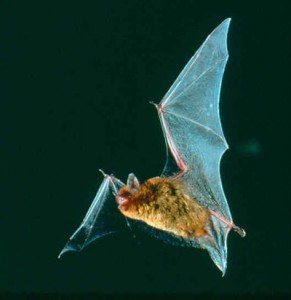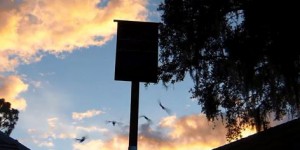There’s no better time to write about bats with Halloween right around the corner. And, on top of that, it’s the first-ever National Bat Week! Find out what you can do to help protect our only mammal that is capable of true flight by clicking on the National Bat Week link and by continuing to read below.
I recently wrote a post titled “Wildlife Wanted” which highlighted actions you can take to help provide habitat for wildlife even in a very developed area such as Pinellas County. Number six on the 10-step list was to “Provide Bird/Bat Houses…” so I wanted to take this opportunity to explore this…
 Bats are an amazing species for a variety of reasons, but two reasons that many people are fond of them is for their pest control and nutrient services. Bats can consume up to 3,000 insects a night and when female bats are nursing their young, their energy requirement is even higher! To put this into perspective for you, a nursing bat can consume up to 2/3 of its body weight daily, which is equivalent to a 150-pound human consuming 100 pounds of food per day! There is no doubt that is a lot of food and what goes in must come out 😉 As they say, everything that eats poops, right? The neat thing about bat poop or guano is that you can use it as a natural fertilizer. It’s true. So not only can bats help to keep the mosquito populations under control, but they can help keep your garden healthy too!
Bats are an amazing species for a variety of reasons, but two reasons that many people are fond of them is for their pest control and nutrient services. Bats can consume up to 3,000 insects a night and when female bats are nursing their young, their energy requirement is even higher! To put this into perspective for you, a nursing bat can consume up to 2/3 of its body weight daily, which is equivalent to a 150-pound human consuming 100 pounds of food per day! There is no doubt that is a lot of food and what goes in must come out 😉 As they say, everything that eats poops, right? The neat thing about bat poop or guano is that you can use it as a natural fertilizer. It’s true. So not only can bats help to keep the mosquito populations under control, but they can help keep your garden healthy too!
Here is the scoop if you want to attract bats to your yard. There are 1,100 species of bats in the world, 48 in the United States and 13 in Florida. Of those 13, you can attract 4 with a bat house: the Evening, Big Brown, Brazilian free-tailed and Southeastern bat. In the natural environment, bats roost in caves and trees, but with as much development as Florida has seen and will continue to see, bats’ opportunity to find habitat in trees is diminishing. Providing a bat house is one way to help provide additional shelter options for these creatures.
Just as people are very particular in what they want to call their home, bats tend to be pretty picky about bat houses too, so you want to make sure you do your research before you build or buy one to put up in your yard. The University of Florida put out this EDIS publication on “Effective Bat Houses for Florida”. EDIS is the Electronic Data Information Source of UF/IFAS Extension, a collection of information on topics relevant to you.
If you don’t have a yard to put a bat house in, you can still help by encouraging others to help protect their natural environment. For example, bats may roost in Spanish moss, dead and hanging palm fronds, or inside hallowed out trees. You can support people to leave these roost sites as they are. Also, you can promote the use of native plants in landscapes as they tend to attract non-pest insects which in turn can attract bats.
Everyone can play a part in bat conservation! What will you do for National Bat Week? Let me know on Facebook or Twitter. I know one thing you can do…bring a pre-schooler to Book Time at Brooker this week to learn about bats!
 1
1

